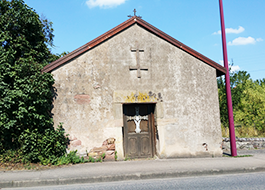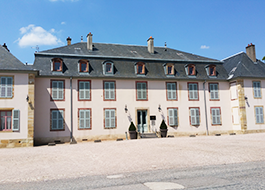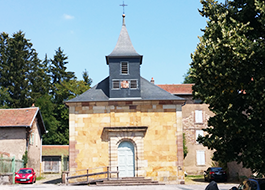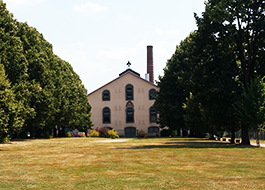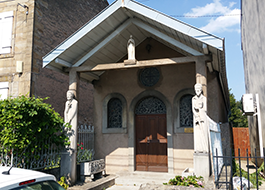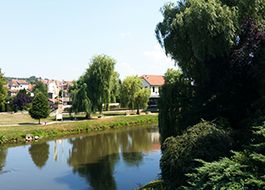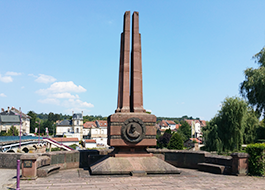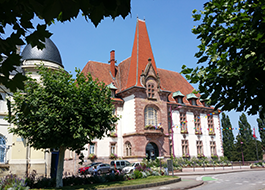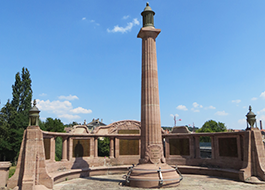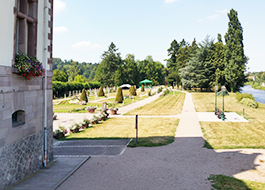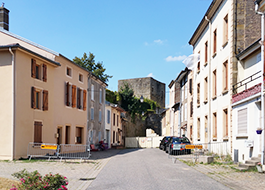Baccarat
Durée visite : 300 minutes
Moyen : Pédestre
A l’origine faubourg de Deneuvre, Baccarat tient peut-être son nom de Bacchi-ara ou autel de Bacchus. C’est le nom du castellum romain, appelé tour du Bacha, situé sur les hauteurs de Deneuvre. Baccarat était le chef-lieu d’une châtellenie de l’évêque de Metz. En 1305, Henri de Blâmont, voué de l’évêque, édifie au bas de l’éperon la tour des Voués. Un faubourg se développe là, donnant naissance à Baccarat. Vers 1450, la cité doit sa prospérité à ses drapiers et à son vin. En1764, l’évêque de Metz désirant écouler la production locale de bois de chauffage, une verrerie est créée sous la direction d’Antoine Renaut. Elle est cédée à la Compagnie des Cristalleries en 1881. Sa renommée devient mondiale et assure le développement de la ville.La Grande Guerre stoppe cet essor. L’entre-deux-guerres est marquée par la construction de l’église, du pont et de l’hôtel de ville. En 1944, les destructions, notamment celle de l’église Saint-Rémy, marquent la cité. Protégée par le Schutzwall West allemand, Baccarat est néanmoins libérée par la 2e division blindée le 31 octobre. Son dynamisme industriel reprend les années suivantes.
Originally a suburb of Deneuvre, Baccarat may have its name bacchi-ara or Bacchus altar. It is the name of the Roman castellum, called the Bacha Tower, located on the heights of Deneuvre. Baccarat was the capital of a castle of the bishop of Metz. In 1305, Henri de Blâmont, the bishop’s doomed, built the tower of the Dooms at the bottom of the spur. A suburb develops there, giving birth to Baccarat. Around 1450, the city owed its prosperity to its drapers and wine. In 1764, the Bishop of Metz wanted to sell the local production of firewood, a glass factory was created under the direction of Antoine Renaut. It was sold to the Crystal Company in 1881. Its reputation became global and ensured the development of the city. The Great War stopped this boom. The interwar period was marked by the construction of the church, the bridge and the town hall. In 1944, the destruction, including that of the Church of Saint Remy, marked the city. Protected by the German Schutzwall West, Baccarat was nevertheless liberated by the 2nd Armoured Division on 31 October. Its industrial dynamism resumed in the following years.
Am Anfang von Deneuvre hat Baccarat vielleicht seinen Namen Bacchi-ara oder Bacchus-Altar. Dies ist der Name des römischen Castellum, genannt Bacha-Turm, auf den Höhen von Deneuvre. Baccarat war die Hauptstätte einer Châtellenie des Bischofs von Metz. Im Jahr 1305 baute Henri de Blâmont, der dem Bischof geweiht war, am Unterteil des Sporns den Turm der Geweihten auf. Ein Vorort entwickelt sich dort und gebiert Baccarat. Um 1450 verdankt die Stadt ihren Wohlstand ihren Bettlaken und ihrem Wein. 1764, als der Bischof von Metz die lokale Produktion von Brennholz absetzen wollte, wurde unter der Leitung von Antoine Renaut eine Glasfabrik gegründet. Sie wurde 1881 an die « Compagnie des Cristalleries » abgetreten. Sein Ruf wird global und sichert die Entwicklung der Stadt. Der Große Krieg stoppt diesen Aufschwung. Die Zwischenkriegszeit ist durch den Bau der Kirche, der Brücke und des Rathauses gekennzeichnet. 1944 prägten die Zerstörungen, insbesondere die der Kirche Saint-Rémy, die Stadt. Baccarat, geschützt durch den deutschen Schutzwall West, wurde jedoch am 31. Oktober von der 2. Panzerdivision freigelassen. Seine industrielle Dynamik erholt sich in den folgenden Jahren.

Coupé en chef de gueules au dextrochère de carnation vêtu d’azur, mouvant d’un nuage d’argent, tenant une épée haute d’argent garnie d’or, accostée de deux cailloux de même ; en pointe au verre à pied d’argent.
Ce sont les armes du chapitre de la cathédrale de Metz, avec en pointe un verre à pied symbolisant la cristallerie. En effet Baccarat, célèbre par sa cristallerie de renommée mondiale, était le siège d’une châtellenie de l’évêché de Metz.
Cut in chief of mouths to the dextrochère of carnation dressed in azure, moving from a cloud of silver, holding a high silver sword garnished with gold, accosted with two pebbles of the same; point to the glass on silver foot.
These are the weapons of the chapter of Metz Cathedral, with a glass on foot symbolizing the crystallization. Indeed Baccarat, famous for its world-renowned crystal factory, was the seat of a castle of the bishop’s office of Metz.
Häuptlings-Häuptlings-Dextrocher in azurblauen Kleidern, bewegt mit einer silbernen Wolke, hält ein silbernes Schwert mit Gold, mit zwei Steinen ebenso anlegt; An der Spitze im Glas zu Fuß silbern.
Das sind die Waffen des Kapitels der Kathedrale von Metz, mit einem Glas zu Fuß, das die Kristallfabrik symbolisiert. Tatsächlich war Baccarat, berühmt durch seine weltberühmte Kristallfabrik, der Sitz einer Kastanie des Bistums Von Metz.

Les habitants de Baccarat s’appellent les Bachâmois et les Bachâmoises.
The inhabitants of Baccarat are called the Bachâmois and the Bachâmoises.
Die Einwohner von Baccarat heißen die Bachâmois und die Bachâmoises.
Les points de visites
.
Elle est située sur le ban communal de Gélacourt. Sainte Catherine était une cense répertoriée en 1832. C’est à dire une terre soumise au cens, redevance payée pour des terres, moulins, fours ou autres. La chapelle est de 1635. On note une correction de date sur le linteau de la porte. Celle ci est ornée d’une croix en fer forgé, avec un ange tenant une bannière, deux cœurs et un oiseau.
It is located on the communal ban of Gelacourt. St. Catherine was a censor listed in 1832. That is, land subject to the censors, royalty paid for land, mills, furnaces or other. The chapel is from 1635. There is a date correction on the lintel of the door. It is decorated with a wrought iron cross, with an angel holding a banner, two hearts and a bird.
Sie befindet sich auf dem Gemeindegebiet von Gélacourt. Heilige Katharina war eine 1832 gelistete Kirche. Das heißt, ein Land, das dem Cens unterliegt, eine Gebühr, die für Land, Mühlen, Öfen oder anderes gezahlt wird. Die Kapelle ist 1635. Es gibt eine Datumskorrektur am Türsturz. Es ist mit einem Kreuz aus Schmiedeeisen geschmückt, mit einem Engel, der ein Banner, zwei Herzen und einen Vogel hält.
.
Ce magasin est situé 2, rue des Cristalleries. Il vous propose à la vente les superbes productions des ouvriers de la cristallerie. Bien accueillis et guidés par un personnel dynamique, vous vous laisserez, sans doute, séduire par les merveilles du savoir-faire de ces véritables artistes. La marque a essaimé dans le monde entier. New-York, Moscou, Varsovie, Hambourg, Bakou accueillent des points de vente. Et ce sont que quelques exemples parmi des centaines. Paris propose un musée-galerie. Milan et Miami possèdent leurs Bar Lounge.
This store is located at 2 Cristalleries Street. It offers you for sale the superb productions of the workers the crystal factory. Well-received and guided by a dynamic staff, you will no doubt be seduced by the marvels of the know-how of these true artists. The brand has spread all over the world. New York, Moscow, Warsaw, Hamburg, Baku host outlets. And these are just a few examples out of hundreds. Paris offers a museum-gallery. Milan and Miami have their Own Bar Lounge.
Dieser Laden befindet sich in der Rue des Cristalleries 2. Er bietet Ihnen zum Verkauf die hervorragenden Produktionen der Arbeiter die Kristallfabrik. Sie werden von einem dynamischen Personal willkommen geheißen und geleitet und werden sich zweifellos von den Wundern des Know-hows dieser wahren Künstler verführen lassen. Die Marke hat sich auf der ganzen Welt verbreitet. New York, Moskau, Warschau, Hamburg, Baku bieten Verkaufsstellen an. Und das sind nur ein paar Beispiele von hunderten. Paris bietet ein Museum-Galerie. Mailand und Miami besitzen ihre Bar Lounge.
.
Le musée Baccarat est situé dans la manufacture même, au 2 rue des Cristalleries. Il regroupe 200 objets de cristal dans quatre salles dont une technique. Le musée de Baccarat a été entièrement rénové en 2015. Il se trouve au cœur du Château, l’ancienne demeure des directeurs de la manufacture. Dans une scénographie raffinée, le visiteur découvre une sélection de pièces emblématiques. Parmi les chefs-d’œuvre exposés, l’aiguière offerte à Charles X, le premier roi à visiter la manufacture en 1828, le candélabre de la Tsarine à 24 bougies et le vase Trois Grâces, présenté lors de l’Exposition internationale de Nancy, en 1909.
The Baccarat Museum is located in the factory itself, at 2 rue des Cristalleries. It brings together 200 crystal objects in four rooms, one of which is a technique. The Baccarat Museum was completely renovated in 2015. It is located in the heart of the Castle, the former home of the directors of the factory. In a refined set design, the visitor discovers a selection of emblematic pieces. Among the masterpieces on display were the needle given to Charles X, the first king to visit the factory in 1828, the Tsarina’s candelabra with 24 candles and the Three Graces vase, presented at the Nancy International Exhibition in 1909.
Das Museum Baccarat befindet sich in der Manufaktur in der Rue des Cristalleries 2. Es umfasst 200 Kristallobjekte in vier Sälen, darunter eine Technik. Das Museum von Baccarat wurde 2015 komplett renoviert. Es befindet sich im Herzen des Schlosses, dem ehemaligen Haus der Manufakturen. In einer raffinierten Szenografie entdeckt der Besucher eine Auswahl an ikonischen Stücken. Unter den ausgestellten Meisterwerken ist die Spitztasche, die Charles X. geschenkt wurde, der erste König, der 1828 die Manufaktur besuchte, der 24-Kerzen-Kaner der Zarin und die Vase Trois Graces, die 1909 auf der Internationalen Ausstellung von Nancy präsentiert wurde.
.
Edifiée en 1775, la chapelle Sainte-Anne était destinée aux ouvriers des cristalleries. Elle fait partie d’un ensemble de constructions. On y trouve un château, une usine, des bureaux et des maisons ouvrières. Cette chapelle présente une architecture dépouillée. Sa façade carrée est recouverte par des moellons de couleur ocre. Jadis, le toit de la chapelle était recouvert d’ardoises. Aujourd’hui, seul subsiste le clocher en pavillon. La chapelle n’est accessible que durant l’été. Elle accueille des expositions temporaires, en lien avec le musée voisin et l’histoire de la ville. Sa bonne acoustique autorise la tenue de concerts.
Built in 1775, the Chapel of St. Anne was intended for the workers of the crystal mills. It is part of a set of buildings. There is a castle, a factory, offices and working-class houses. This chapel has a stripped-down architecture. Its square façade is covered by ochre-coloured rubbs. In the past, the roof of the chapel was covered with slate. Today, only the bell tower remains in the pavilion. The chapel is only accessible during the summer. It hosts temporary exhibitions, in connection with the nearby museum and the history of the city. Its good acoustics allow the holding of concerts.
Die 1775 erbaute Kapelle Sainte-Anne war für die Arbeiter der Kristallfabriken bestimmt. Sie ist Teil einer Reihe von Bauten. Es gibt ein Schloss, eine Fabrik, Büros und Arbeiterhäuser. Diese Kapelle hat eine ausgekleidete Architektur. Die quadratische Fassade ist mit ockerfarbenen Flözen bedeckt. Früher war das Dach der Kapelle mit Schiefer bedeckt. Heute gibt es nur noch den Glockenturm im Pavillon. Die Kapelle ist nur im Sommer zugänglich. Es beherbergt temporäre Ausstellungen in Verbindung mit dem benachbarten Museum und der Geschichte der Stadt. Seine gute Akustik erlaubt Konzerte.
.
En 1764, l’évêque de Metz, Monseigneur de Montmorency-Laval, gros propriétaire de la forêt vosgienne, désire trouver un débouché à son bois. Celui-ci n’est plus utilisé par les salines de Roziéres, désormais hors d’usage. Il convainc Louis XV de contrer les importations de verres d’art de Bohême. La verrerie de Baccarat est autorisée par le roi. Reprise par le maître-verrier Renault en 1773, elle produit de la gobeleterie, des vitres et du verre de table. En 1785, elle est en volume la troisième en Europe, dépassée par Saint-Louis-Les-Bitche et Saint-Quirin. Elle périclite sous la Révolution. En 1816, son nouveau propriétaire, d’Artigues la transforme en cristallerie. La technique anglaise est préférée à celle de Bohême. Son succès est rapide mais les coûts trop importants. L’usine passe en 1822 à Godard-Desmarest, associé au polytechnicien Toussaint. Cette paire est à l’origine des deux dynasties qui vont contrôlaient l’entreprise. Plusieurs fois médaillée d’or aux expositions, la cristallerie passe de 300 à 2000 employés entre 1823 et 1869. En 1860, la marque est déposée . Elle figure toujours sur les produits aujourd’hui. Commandes des maisons princières, exportations vers l’Asie stimulent l’activité. En 1868, Paul Michaud gendre de Toussaint dirige la société. Son fils prend le relais jusqu’en 1936. Ils imposent leur méthodes, empreintes de catholicisme social. A la fin du XXe siècle, la cristallerie possède 13 magasins aux USA. Elle se lance dans la bijouterie et la parfumerie, et collabore avec le designer Philippe Starck. Ce dernier réinterprète les verres Harcourt, fleuron le la marque. De 1853 à 1989, le capital reste dans la famille de Chambrun, liée par mariage aux Godard. Rachetée alors par les Taittinger, l’entreprise change ensuite plusieurs fois de mains. Début 2021, un fond d’investisseurs basé à Hong-Kong reprend l’affaire.
In 1764, the Bishop of Metz, Monsignor of Montmorency-Laval, the great owner of the Vosgian forest, wanted to find an outlet for his wood. This is no longer used by roziéres salt flats, which are now out of use. He convinced Louis XV to counter imports of Bohemian art glasses. Baccarat glassware is authorized by the king. Taken over by the master glassmaker Renault in 1773, it produces cupboards, windows and table glass. In 1785, it was the third largest in Europe, surpassed by St. Louis-Les-Bitche and Saint-Quirin. It faltered during the Revolution. In 1816, its new owner, d’Artigues, transformed it into a crystal factory. The English technique is preferred to that of Bohemia. Its success is rapid but the costs too high. The factory moved to Godard-Desmarest in 1822, associated with the polytechnic Toussaint. This pair is at the origin of the two dynasties that will control the company. Several times a gold medallist at exhibitions, the crystal factory increased from 300 to 2000 employees between 1823 and 1869. In 1860, the trademark was registered. It is still on the products today. Orders of princely houses, exports to Asia stimulate activity. In 1868, Paul Michaud, Toussaint’s son-in-law, ran the company. His son took over until 1936. They impose their methods, imprinted with social Catholicism. At the end of the 20th century, the crystal factory had 13 stores in the U.S. She started in jewelry and perfumery, and collaborated with designer Philippe Starck. The latter reinterprets Harcourt glasses, the brand’s flagship. From 1853 to 1989, the capital remained in the Chambrun family, linked by marriage to the Godards. Purchased by the Taittinger, the company then changed hands several times. In early 2021, a Hong Kong-based investor fund took over the business.
1764 möchte der Bischof von Metz, Monsignore de Montmorency-Laval, ein großer Eigentümer des Vogesenwaldes, einen Absatzmarkt für sein Holz finden. Es wird nicht mehr von den Salinen von Roziéres verwendet, die jetzt außer Betrieb sind. Er überzeugte Louis XV, dem Import von Böhmischen Kunstgläsern entgegenzuwirken. Die Glashütte von Baccarat wird vom König genehmigt. Sie wurde 1773 vom Glasmeister Renault übernommen und produziert Becher, Scheiben und Tafelglas. 1785 war sie die drittgrößte in Europa, überholt von Saint-Louis-Les-Bitche und Saint-Quirin. Sie geht unter die Revolution. 1816 wurde sie von ihrem neuen Besitzer, von Artigues, in eine Kristallfabrik verwandelt. Die englische Technik wird der von Böhmen vorgezogen. Sein Erfolg ist schnell, aber die Kosten zu hoch. Die Fabrik wurde 1822 in Godard-Desmarest in Verbindung mit dem Polytechniker Toussaint. Dieses Paar ist der Ursprung der beiden Dynastien, die das Unternehmen kontrollieren werden. Mehrere Goldmedaillengewinner auf Ausstellungen, die Kristallfabrik von 300 auf 2000 Mitarbeiter zwischen 1823 und 1869. Im Jahr 1860 ist die Marke eingetragen. Sie ist auch heute noch auf den Produkten zu lesen. Fürstlichen Hausbestellungen, Exporte nach Asien stimulieren die Aktivität. 1868 leitet Paul Michaud, Schwiegersohn von Toussaint, das Unternehmen. Sein Sohn übernimmt bis 1936. Sie setzen ihre Methoden durch, die von sozialem Katholizismus geprägt sind. Am Ende des 20. Jahrhunderts hat die Kristallfabrik 13 Läden in den USA. Sie arbeitet im Juweliergeschäft und in der Parfümerie und arbeitet mit dem Designer Philippe Starck zusammen. Letzterer interpretiert die Harcourt-Gläser neu, das Flaggschiff die Marke. Von 1853 bis 1989 blieb das Kapital in der Familie von Chambrun, durch Ehe mit godard verbunden. Das Unternehmen, das dann von den Taittingers übernommen wurde, wechselt dann mehrmals die Hände. Anfang 2021 übernahm ein Invest-Fonds mit Sitz in Hongkong den Fall.
.
La rue Humbépaire rappelle un ancien faubourg de Baccarat, où il y eut un culte et un prieuré consacrés à Saint Wolfgang, délaissé en 1536. Chapelle et prieuré disparurent à la Révolution. Après 1945, Louis Vigneron donna un terrain à l’évêché de Nancy, pour y construire une chapelle. Celle-ci est dédiée à Notre Dame de la Médaille miraculeuse. Elle fut construite en 1948. D’architecture moderne et sobre, elle est précédée d’un porche doté de statues de Saint Pierre et Saint Paul. La vierge orne la poutre transversale. Les 4 vitraux de la façade et 16 autres à l’intérieur sont en dalles de verre. Il sont dus au maître-verrier Gabriel Loire, installé à Chartres. Celui-ci, 1904 -1996, utilise aussi bien la technique traditionnelle au plomb que des techniques modernes, comme le béton, qu’il a étudiées auprès du mouvement Bauhaus, ou le thermoformage. Son œuvre est abondante. Il a installé des vitraux dans environ 450 édifices en France, 25 en Grande-Bretagne, 18 en Allemagne. A l’intérieur, on note des appliques en cristal Baccarat, des œuvres du ferronnier d’art local Mychajlow, notamment un Christ en croix en fer forgé, un tabernacle, une lampe de sanctuaire ainsi que le support pour la statue de la Vierge. En retrait et à gauche se trouve un campanile à bâtière. Un carillon de 6 cloches y est abrité. Il est dû à la société savoyarde Paccard, créée en 1796 et aujourd’hui dirigée par la septième génération.
Humbépaire Street recalls an ancient suburb of Baccarat, where there was a cult and priory dedicated to Saint Wolfgang, abandoned in 1536. Chapel and priory disappeared during the Revolution. After 1945, Louis Vigneron gave land to the Bishop of Nancy, to build a chapel. This one is dedicated to Our Lady of the Miraculous Medal. It was built in 1948. Modern and sober in architecture, it is preceded by a porch with statues of St. Peter and St. Paul. The virgin adorns the cross beam. The 4 stained glass windows on the façade and 16 others inside are made of glass slabs. They are due to master glassmaker Gabriel Loire, based in Chartres. This one, 1904-1996, uses both traditional lead technique and modern techniques, such as concrete, which he studied with the Bauhaus movement, or thermoforming. His work is abundant. He installed stained glass windows in about 450 buildings in France, 25 in Britain, 18 in Germany. Inside are Baccarat crystal appliques, works by local ironworker Mychajlow, including a wrought iron cross Christ, a tabernacle, a shrine lamp and the support for the statue of the Virgin. In the background and to the left is a bell tower with a building. A chime of 6 bells is housed there. It is due to the Savoyard company Paccard, founded in 1796 and now run by the seventh generation.
Die Rue Humbépaire erinnert an einen ehemaligen Vorort von Baccarat, wo es einen Kult und ein Priorat, der dem Heiligen Wolfgang gewidmet war, im Jahre 1536 verlassen. Kapelle und Priora verschwanden bei der Revolution. Nach 1945 gab Louis Vigneron dem Bistum Nancy ein Grundstück, um dort eine Kapelle zu bauen. Diese ist unserer Lieben Frau der Wundermedaille gewidmet. Sie wurde 1948 erbaut. Mit moderner und nüchterner Architektur geht ihr eine Veranda mit Statuen des hl. Petrus und des hl. Paulus voraus. Die Jungfrau ziert den Querbalken. Die 4 Glasfenster der Fassade und 16 weitere im Inneren sind aus Glasplatten. Sie sind dem Verarbeitermeister Gabriel Loire in Chartres zuzuerkennen. 1904 -1996 verwendet er sowohl die traditionelle Bleitechnik als auch moderne Techniken wie Beton, die er bei der Bauhaus-Bewegung studiert hat, oder Thermoform. Sein Werk ist reichlich vorhanden. Er installierte Glasfenster in etwa 450 Gebäuden in Frankreich, 25 in Großbritannien, 18 in Deutschland. Im Innern finden sich Aufhänge aus Baccarat-Kristall, Werke des lokalen Kunstschmieds Mychajlow, darunter ein Geschmiedee-Kreuz-Christus, ein Tabernakel, eine Schreinlampe sowie die Stütze für die Statue der Muttergottes. Hinter und links befindet sich ein Kampanile mit Bauten. Dort ist ein Glockenspiel mit 6 Glocken untergebracht. Es ist auf die savoyische Firma Paccard zurückzuführen, die 1796 gegründet wurde und heute von der siebten Generation geleitet wird.
.
Longue de 160km, la Meurthe prend sa source à la Fontaine des Voleurs, entre le Hohneck et le col de la Schlucht, dans le département des Vosges. Elle s’unit à la Moselle au lieu-dit La Gueule d’enfer, à Custines. L’étymologie celte de la Meurthe désigne les alluvions, les terres d’alluvionnement et par extension les eaux qui charrient, apportent ou enlèvent ces matériaux. La Meurthe est la rivière qui a transporté, au XVIIIe siècle, le plus de bois de charpente et de chauffage, par flottage en trains ou à bûches perdues dans tout le massif vosgien. L’activité du flottage du bois y a perduré du XVe au XIXe siècle. Les points névralgiques étaient le port aux bois de Raon-l’Étape, les ports d’arrivage ou de redistribution de Lunéville et de Nancy. Cela conféra à cette rivière une dimension économique internationale, perdue depuis. Un des plus gros clients de bois de chauffage était la cristallerie de Baccarat. Elle commandait surtout des flottages réguliers à bûches perdues. Ces bois d’une longueur d’un mètre ont pu représenter plus de 10 000 tonnes par an.
160km long, the Meurthe originates at the Fountain of Thieves, between the Hohneck and the Schlucht pass, in the vosges department. It unites with the Moselle at the place called La Gueule d’enfer, in Custines. The Celtic etymology of the Meurthe refers to alluvial lands, alluvial lands and by extension the waters that carry, bring or remove these materials. The Meurthe is the river that transported, in the 18th century, the most lumber and heating, by flotation by trains or logs lost throughout the Vosgien massif. The activity of wood flotation continued from the 15th to the 19th century. The hotspots were the port to the woods of Raon-l’Étape, the ports of arrival or redistribution of Lunéville and Nancy. This gave this river an international economic dimension, which has since been lost. One of the biggest firewood customers was The Baccarat Crystal Factory. It mainly commanded regular fleets with lost logs. These one-metre-long woods may have accounted for more than 10,000 tonnes per year.
Die 160 km lange Meurthe ist am Brunnen der Diebe zwischen dem Hohneck und dem Schluchtpass im Departement Vogesen. Sie vereint sich mit der Mosel am Ort La Gueule d ‘enfer, in Custines. Die keltologische Etymologie der Meurthe bezeichnet die Anschlüssungen, die Entsensungsflächen und im weiteren Sinne die Gewässer, die diese Materialien beschreiten, einbringen oder entfernen. La Meurthe ist der Fluss, der im 18. Jahrhundert das größte Holz aus Bauholz und Heizung transportierte, durch Schwimmen in Zügen oder mit Holzscheiten, die im gesamten Vogesenmassiv verloren gingen. Die Tätigkeit der Holzfleeerei dauerte dort vom 15. bis zum 19. Jahrhundert an. Die neuralgischen Punkte waren der Hafen zu den Wäldern von Raon-l ‘Etape, die Anlieferungs- oder Umverteilungshäfen von Lunéville und Nancy. Das verleiht diesem Fluss eine internationale wirtschaftliche Dimension, die seitdem verloren gegangen ist. Einer der größten Brennholzkunden war die Baccarat-Kristallfabrik. Sie bestellte vor allem regelmäßige Floaten mit verlorenen Scheiterhaufen. Dieses Holz mit einer Länge von einem Meter konnte mehr als 10.000 Tonnen pro Jahr ausmachen.
.
En 1944, la reprise de Baccarat ne fait pas partie des plans des alliés, dans leur marche vers l’Allemagne. Mais l’avancée rapide des forces U.S. les oblige à arrêter le mouvement, afin d’assurer le réapprovisionnement et d’attendre des renforts. Leclerc dispose alors d’un mois pour prendre la ville. Aidé par les résistants français, des commandos anglais, renseigné par des prisonniers allemands, il prépare son plan. La 2e DB est divisée en plusieurs sous-groupements. Ceux-ci se dispersent dans les villages alentours. La 21e Panzer, appuyée par son bataillon anti-char avec une vingtaine de canons 88, est positionnée en face. Le général Von Manteuffel a préparé le terrain avec des champs de mines, des trous individuels, des fossés antichars, des positions fortifiées et un rideau d’infanterie. Les sous-groupements placés aux alentours font diversion. Ils permettent une entrée surprise dans le Nord de Baccarat le 31 octobre. La 2e DB s’empare du pont de la Meurthe grâce au lieutenant Mac Clenahan, avant que les Allemands puissent le détruire. La ville est libérée et le nœud routier est dégagé, permettant ainsi un meilleur déplacement des troupes. Le 3 novembre 1944, le général Leclerc, ses officiers et la municipalité de Baccarat dégustent du champagne, avec la FFI locale et son chef l’abbé Stutzmann. On le boit dans les coupes de cristal, commandées par Goering aux célèbres cristalleries. Le 4 novembre, le général s’incline devant les 45 tués de la division. Cette attaque réussie est connue comme le Menuet de Baccarat.
In 1944, the recapture of Baccarat was not part of the Allied plans in their march to Germany. But the rapid advance of U.S. forces forced them to stop the movement, in order to ensure resupply and wait for reinforcements. Leclerc then has one month to take the city. Aided by the French resistance fighters, English commandos, informed by German prisoners, he prepared his plan. The 2nd DB is divided into several subgroups. These disperse in the surrounding villages. The 21st Panzer, supported by its anti-tank battalion with about 20 88 guns, is positioned opposite. General Von Manteuffel prepared the ground with minefields, individual holes, anti-tank ditches, fortified positions and an infantry curtain. The subgroups in the vicinity are a diversion. They allow a surprise entry into the north of Baccarat on October 31st. The 2nd DB captured the Meurthe Bridge thanks to Lieutenant Mac Clenahan, before the Germans could destroy it. The city was liberated and the road node was cleared, allowing for a better movement of the troops. On November 3, 1944, General Leclerc, his officers and the municipality of Baccarat enjoyed champagne, along with the local FFI and its leader, Father Stutzmann. It is drunk in crystal cups, ordered by Goering with famous crystals. On November 4, the general bowed to the 45 killed of the division. This successful attack is known as the Baccarat Menuet.
Im Jahr 1944 war die Wiederaufnahme von Baccarat nicht Teil der Pläne der Alliierten, auf ihrem Weg nach Deutschland. Aber der schnelle Vormarsch der U.S.-Kräfte zwingt sie, die Bewegung zu stoppen, um die Nachschubversorgung zu sichern und auf Verstärkung zu warten. Leclerc hat dann einen Monat Zeit, um die Stadt zu nehmen. Unterstützt von französischen Widerstandskämpfern, englischen Kommandos, von deutschen Gefangenen informiert, bereitet er seinen Plan. Die 2. DB ist in mehrere Untergruppen unterteilt. Diese verteilen sich in die umliegenden Dörfer. Der 21. Panzer, unterstützt von seinem Panzerbataillon mit etwa 20 88-Kanonen, ist gegenüber positioniert. General Von Manteuffel bereitete den Boden mit Minenfeldern, individuellen Löchern, Panzergräben, befestigten Stellungen und einem Vorhang der Infanterie. Die umliegenden Untergruppierungen sind ein Ablenkungsmanöver. Sie ermöglichen einen überraschenden Einstieg in den Norden von Baccarat am 31. Oktober. Die 2. DB übernahm die Brücke von La Meurthe dank Leutnant Mac Clenahan, bevor die Deutschen sie zerstören konnten. Die Stadt wird befreit und der Verkehrsknotenpunkt ist frei, so dass die Truppen besser geräumt werden können. Am 3. November 1944 verabscheuten General Leclerc, seine Offiziere und die Gemeinde Baccarat Champagner, zusammen mit der örtlichen FFI und ihrem Chef, Abbé Stutzmann. Man trinkt es aus den Kristallschnitten, die Göring von den berühmten Kristallen in Auftrag gegeben hat. Am 4. November verneigt sich der General vor den 45 Toten der Division. Dieser erfolgreiche Angriff ist bekannt als Baccarat Menuet.
.
L’église Sain-Rémy, construite entre 1954 et 1957 par l’architecte d’origine grecque Nicolas Kazis, constitue un beau témoignage de la Deuxième reconstruction en Lorraine. Élève d’Auguste Perret, Nicolas Kazis souhaite concevoir une œuvre d’art totale. Il s’entoure d’une équipe de peintres et de sculpteurs, parmi lesquels Claude Idoux ou François Stahly. Ces derniers réaliseront les superbes verrières en dalles de cristal ornant l’église. Saint-Rémy de Baccarat se distingue par son imposant campanile triangulaire, haut de 55 mètres. L’originalité de l’édifice repose sur l’omniprésence du triangle équilatéral, symbole de la Sainte-Trinité, ainsi que sur la simplicité des matériaux. Béton armé, cristal et bois y ont été employés. L’architecture est rigoureusement pensée. Elle est sublimée à l’intérieur par le jeu de lumières des vitraux. Les 20 000 plaques de cristal, et leurs 150 teintes différentes, ont été spécialement créées pour ce chantier. Elles sont nées de la collaboration des artistes et du personnel de la cristallerie.
The Sain-Rémy church, built between 1954 and 1957 by the Greek-born architect Nicolas Kazis, is a beautiful testimony to the Second Reconstruction in Lorraine. A student of Auguste Perret, Nicolas Kazis wants to design a total work of art. He surrounded himself with a team of painters and sculptors, among them Claude Idoux or François Stahly. They will create the beautiful crystal slab glass windows adorning the church. Saint-Rémy de Baccarat is distinguished by its imposing triangular bell tower, 55 metres high. The originality of the building is based on the omnipresence of the equilateral triangle, symbol of the Holy Trinity, as well as on the simplicity of the materials. Armed concrete, crystal and wood were used there. The architecture is rigorously thought out. It is enhanced inside by the play of stained glass lights. The 20,000 crystal plates, and their 150 different shades, were specially created for this project. They were born out of the collaboration of the artists and staff of the crystal factory.
Die Kirche Sain-Rémy, die zwischen 1954 und 1957 vom Architekten griechischer Herkunft Nicolas Kazis erbaut wurde, ist ein schönes Zeugnis des Zweiten Wiederaufbaus in Lothringen. Nicolas Kazis, schüler von Auguste Perret, möchte ein Gesamtkunstwerk entwerfen. Er umgibt sich mit einem Team von Malern und Bildhauern, darunter Claude Idoux oder François Stahly. Letztere werden die herrlichen Glasscheiben aus Kristallplatten herstellen, die die Kirche verziert. Saint-Rémy de Baccarat zeichnet sich durch sein imposantes dreieckiges Glockenlager aus, das 55 Meter hoch ist. Die Originalität des Gebäudes beruht auf der Allgegenwart des gleichseitigen Dreiecks, dem Symbol der Heiligen Dreifaltigkeit, sowie auf der Einfachheit der Materialien. Stahlbeton, Kristall und Holz wurden dort verwendet. Die Architektur ist rigoros durchdacht. Sie wird innerlich durch das Lichtspiel der Glasfenster sublimiert. Die 20.000 Kristallplatten und ihre 150 verschiedenen Farbtöne wurden speziell für diese Baustelle geschaffen. Sie sind aus der Zusammenarbeit der Künstler und des Personals der Kristallfabrik entstanden.
.
Le bâtiment est situé 2 rue Adrien Michaut. Il a été construit en 1924 par l’architecte Deville. Ce dernier, d’origine nantaise, et également graveur, a effectué une partie de sa carrière aux Etats-Unis avant 1914. Le style de l’édifice s’inspire des maisons flamandes. Il a été offert à la commune par les frères Henri et Adrien Michaut, fils de Paul ancien directeur de la cristallerie. En échange, la mairie devait entretenir le parc situé à l’arrière. Adrien a dirigé l’entreprise de 1883 à 1936 et fut maire de la ville de 1880 à 1919. Henri fut sénateur. Sur la façade, des macarons sculptés par Malherbe, dans le grès rose des Vosges, évoquent les métiers du cristal. On y reconnaît un tailleur et un souffleur. L’escalier d’honneur est l’œuvre de Jean Prouvé. La mairie a été rénovée en 2004.
The building is located 2 rue Adrien Michaut. It was built in 1924 by the architect Deville. The latter, of Nantes origin, and also an engraver, spent part of his career in the United States before 1914. The style of the building is inspired by Flemish houses. It was donated to the commune by brothers Henri and Adrien Michaut, son of Paul former director of crystalry. In exchange, the town hall had to maintain the park at the rear. Adrien ran the company from 1883 to 1936 and was mayor of the city from 1880 to 1919. Henri was a senator. On the façade, macaroons carved by Malherbe, in the pink sandstone of the Vosges, evoke the crafts of crystal. There is a tailor and a blower. The staircase of honour is the work of Jean Prouvé. The town hall was renovated in 2004.
Das Gebäude befindet sich 2 rue Adrien Michaut. Es wurde 1924 von dem Architekten Deville gebaut. Letzterer, nantesischer Herkunft, und auch Graveur, hat einen Teil seiner Karriere in den Vereinigten Staaten vor 1914. Der Stil des Gebäudes ist von den flämischen Häusern inspiriert. Es wurde der Gemeinde von den Brüdern Henri und Adrien Michaut, Sohn des ehemaligen Paul-Direktor der Kristallfabrik. Im Gegenzug musste das Rathaus den Park auf der Rückseite pflegen. Adrien leitete das Unternehmen von 1883 bis 1936 und war von 1880 bis 1919 Bürgermeister der Stadt. Henri war Senator. An der Fassade erinnern von Malherbe geschnitzte Makronen aus dem rosa Sandstein der Vogesen an die Berufe des Kristalls. Man erkennt einen Schneider und einen Bläser. Die Ehrentreppe ist das Werk von Jean Prouvé. Das Rathaus wurde 2004 renoviert.
.
C’est un pilier surmonté d’une lanterne des morts. Le tout est en grès. Il est dédié aux victimes des combats du 25 août 1914, et aux enfants de Baccarat tombés pendant la Grande Guerre. Leurs noms sont gravés sur des tables en exèdre derrière l’obélisque. 311 militaires et 7 civils sont cités. L’architecte est Henri Deville, par ailleurs auteur de la mairie. Le sculpteur est Eugène Vallin. Il a été inauguré en 1923, en présence du général Mangin. On peut lire sur une plaque le nom de Paul Michaut. C’est le fils d’Adrien, directeur de la cristallerie et maire de la ville. Il est mort des suites de ses blessures à Nancy, le 10 septembre 1914. Il avait 32 ans.
It is a pillar surmounted by a lantern of the dead. The whole thing is sandstone. It is dedicated to the victims of the fighting of August 25, 1914, and to the children of Baccarat who died during the Great War. Their names are engraved on exhedre tables behind the obelisk. 311 military personnel and 7 civilians are cited. The architect is Henri Deville, who also authored the town hall. The sculptor is Eugene Vallin. It was inaugurated in 1923, in the presence of General Mangin. Paul Michaut’s name can be read on a plaque. He is the son of Adrien, director of the crystal factory and mayor of the city. He died of his injuries in Nancy on September 10, 1914. He was 32.
Es ist ein Pfeiler von einer Laterne der Toten überwunden. Alles aus Sandstein. Es ist den Opfern der Kämpfe vom 25. August 1914 und den Kindern von Baccarat gewidmet, die während des Ersten Weltkriegs gefallen sind. Ihre Namen sind auf Tische eingraviert, die hinter dem Obelisken liegen. 311 Soldaten und sieben Zivilisten werden zitiert. Der Architekt ist Henri Deville, übrigens Autor des Rathauses. Der Bildhauer ist Eugene Vallin. Er wurde 1923 in Anwesenheit von General Mangin eingeweiht. Auf einer Plakette ist der Name Paul Michaut zu lesen. Er ist der Sohn von Adrien, Leiter der Kristallfabrik und Bürgermeister der Stadt. Er starb an den Folgen seiner Verletzungen in Nancy am 10. September 1914. Er war 32 Jahre alt.
.
Il est situé derrière la mairie. Un arborétum et une roseraie sont à voir dans ce jardin à l’anglaise. Il porte le nom de son ancien propriétaire. Sa famille a fait don du terrain pour bâtir l’hôtel de ville. En contrepartie, les édiles devaient entretenir le parc. Promesse tenue, comme vous pouvez le constater. En 2007, une sculpture a été réalisée par le drômois Charlie Skubich, lors du symposium de la sculpture organisé par le Département, dans la cour du château de Lunéville. Confiée à la ville de Baccarat par le Conseil Général, elle a été placée ici en août 2012. Son titre complet est Unité et Diversité-Métissage.
It is located behind the town hall. A arboretum and rose garden are to be seen in this English garden. It is named after its former owner. His family donated the land to build City Hall. In return, the buildings had to maintain the park. Promise kept, as you can see. In 2007, a sculpture was created by Drômois Charlie Skubich, during the symposium of sculpture organized by the Department, in the courtyard of the castle of Lunéville. Trusted to the city of Baccarat by the General Council, it was placed here in August 2012. Its full title is Unity and Diversity-Métissage.
Es liegt hinter dem Rathaus. Ein Arboretum und ein Rosengarten sind in diesem englischen Garten zu sehen. Er trägt den Namen seines früheren Besitzers. Seine Familie hat das Grundstück gespendet, um das Rathaus zu bauen. Im Gegenzug mussten die Gebäude den Park instand halten. Versprechen gehalten, wie Sie sehen können. Im Jahr 2007 wurde eine Skulptur von Drômois Charlie Skubich auf dem Skulpturensymposium des Departements im Hof des Schlosses von Lunéville erstellt. Sie wurde der Stadt Baccarat vom Generalrat anvertraut und im August 2012 hier untergebracht. Sein vollständiger Titel ist Einheit und Vielfalt-Vermischung.
.
La Tour des Voués est le donjon de l’ancien château. Elle fut construite en 1305 par le comte Henri Ier, afin de protéger les habitations. Elle mesure 14 m de large et sa hauteur atteint 30 m. Quant aux murs, percés de fenêtres et de meurtrières, ils font près de 3 m d’épaisseur. Vendue en 1332 par Henri III, la tour est rachetée par Adhémar de Monteil, évêque de Metz. Il la complète par un château autour duquel sera édifiée Baccarat. Le château est démoli au milieu du XVIIe par le duc de Lorraine Charles IV. L’accès à la tour se faisait par une ouverture percée dans le rempart. Cette dernière bien visible est aujourd’hui murée. Le reste des remparts et du château, édifiés en 1330, étaient accessibles par un vaste passage voûté, utilisé encore de nos jours par les riverains.
The Tower of the Doomed is the dungeon of the old castle. It was built in 1305 by Count Henry I to protect the houses. It is 14 m wide and its height reaches 30 m. As for the walls, pierced by windows and murderous, they are nearly 3 m thick. Sold in 1332 by Henry III, the tower was bought by Adhémar de Monteil, Bishop of Metz. He completed it with a castle around which Baccarat was built. The castle was demolished in the mid-17th century by the Duke of Lorraine Charles IV. Access to the tower was through an opening pierced in the rampart. The latter is now walled. The rest of the ramparts and the castle, built in 1330, were accessible by a vast vaulted passage, still used today by local residents.
Der Turm der Geweihten ist der Kerker des alten Schlosses. Sie wurde 1305 von Graf Heinrich I. erbaut, um die Häuser zu schützen. Sie ist 14 m breit und 30 m hoch. Die Wände, die von Fenstern und Mörderinnen durchbohrt sind, sind fast 3 m dick. Der 1332 von Heinrich III. verkaufte Turm wird von Adhämar de Monteil, Bischof von Metz, aufgekauft. Er vervollständigt sie durch ein Schloss, um das Baccarat errichtet wird. Das Schloss wird in der Mitte des siebzehnten vom Herzog von Lothringen Charles IV. Abgerissen. Der Zugang zum Turm erfolgte durch eine durchbohrte Öffnung des Bollwerks. Letztere ist heute gut sichtbar. Der Rest der 1330 erbauten Stadtmauer und des Schlosses war durch einen ausgedehnten Gewölbegang zugänglich, der bis heute von den Anwohnern genutzt wird.
.
Située au 10 rue des Moulins, cette petite chapelle est adossée aux restes des remparts. A côté se trouve un passage voûté, leur seul vestige, avec la tour des Voués. Elle date de la première moitié du XIXe siècle. Un banc, un autel et une statue de la Vierge meublent l’endroit. Notre-Dame-de-la- Délivrance est invoquée pour les prisonniers, les futures mères, les personnes soumises à la tentation.
Located at 10 rue des Moulins, this small chapel is backed by the remains of the ramparts. Next to it is a vaulted passage, their only remnant, with the tower of the Doomed. It dates from the first half of the 19th century. A bench, an altar and a statue of the Virgin furnish the place. Our Lady of deliverance is invoked for prisoners, mothers-to-be, people subject to temptation.
In der Rue des Moulins 10 gelegen, ist diese kleine Kapelle an den Resten der Stadtmauer angelehnt. Daneben befindet sich eine gewölbte Passage, deren einziges Überbleibsel, mit dem Turm der Täste. Sie stammt aus der ersten Hälfte des 19. Jahrhunderts. Eine Bank, ein Altar und eine Statue der Jungfrau befestigen den Platz. Notre-Dame-de-la-Erlösung wird für Gefangene, werdende Mütter, Menschen, die der Versuchung ausgesetzt.





